
Imagine the bootlace worm as a master chef, using an array of tools and techniques to break down its meals without a conventional kitchen (or stomach). They’ve carved a niche for themselves in the complex world of marine life, employing methods that might seem downright alien to us. In this article, we’ll explore how bootlace worms digest prey, how their body functions without traditional organs, and why understanding this process is essential for marine biology enthusiasts and curious minds alike.
What Are Bootlace Worms?
Bootlace worms belong to the genus *Lineus* and are often found along the coasts of Europe. These fascinating creatures are sometimes mistaken for pieces of seaweed due to their thin, elongated bodies. Here’s what makes them so intriguing:
- Length: Bootlace worms can grow to extraordinary lengths, with some reported to reach up to 55 meters (that’s about the length of a basketball court!).
- Appearance: They have a striking coloration, often appearing in shades of green or brown, helping them blend into their environment.
- Habitat: You can usually find bootlace worms in shallow coastal waters, where they wiggle through the sand or hide among rocks.
These worms are part of a group called Nemertea, or ribbon worms, which are known for their unique anatomy and remarkable adaptation to their marine environments. Understanding bootlace worms begins with appreciating their extraordinary biology.
How Do They Digest Food?
Now, let’s get to the heart of the matter—how do bootlace worms digest their prey? Unlike animals with traditional digestive systems, bootlace worms don’t have a stomach. Instead, they use a special feeding mechanism that allows them to absorb nutrients directly. Here’s how it works:
1. **Eversion of the Proboscis**: When a bootlace worm catches its prey, it extends a long, slender structure called a proboscis. Think of it as a flexible straw that reaches out to grab food. They often hunt smaller creatures, like crustaceans, using this clever tool.
2. **Secretion of Digestive Enzymes**: Once the proboscis is in place, bootlace worms secrete digestive enzymes that break down the prey’s tissues. This helps turn the solid food into a more liquid form that’s easier to absorb.
3. **Absorption Through the Body Wall**: After the prey is broken down, the nutrients are absorbed directly through the worm’s skin. It’s fascinating to think that they don’t need a stomach at all; their entire body acts as a sponge to soak up the nutrients they need to survive.
This unique method allows bootlace worms to thrive in their environment, showcasing the incredible diversity of life in the ocean.
Why Don’t Bootlace Worms Need a Stomach?
You might be wondering why bootlace worms evolved this way. The answer lies in their habitat and lifestyle. Here are a few reasons why a stomach isn’t necessary:
– **Efficient Feeding**: A stomach might slow down the process of digestion. By absorbing nutrients directly, bootlace worms can eat and digest simultaneously, making them efficient hunters.
– **Adaptation to Environment**: Living in the ocean means that food sources can be scarce. The ability to quickly digest prey without a separate stomach allows bootlace worms to take advantage of whatever food they encounter.
– **Simplicity in Design**: Nature often favors simplicity. Not having a stomach means less energy spent on maintaining complex organs. This can be beneficial in unpredictable environments like the ocean.
Overall, this unique method highlights the bootlace worm’s fascinating adaptation to its surroundings.
Comparative Digestion in Other Marine Life
If you find the bootlace worm’s digestion intriguing, you might want to compare it to other marine creatures. Many marine animals have evolved unique methods to process food. For example:
– **Octopus**: They have a beak-like mouth and a specialized stomach that can break down prey into a more manageable form before further digestion occurs.
– **Sea Cucumbers**: These fascinating creatures extract nutrients using a different mechanism, filtering water through their bodies and absorbing nutrients while expelling waste.
– **Jellyfish**: They use stinging cells to capture prey and a simple gastrovascular cavity for digestion, showcasing another method of nutrient absorption.
Understanding these differences can help us appreciate the unique evolutionary paths of marine life.
The Importance of Studying Bootlace Worms
Researching bootlace worms isn’t just a matter of curiosity; it has real-world implications. Here are some reasons why studying these creatures matters:
– **Biodiversity Insights**: Bootlace worms help scientists understand how different species adapt to various environments. Their unique digestive methods may provide clues to evolutionary biology.
– **Ecosystem Roles**: As predators in their marine ecosystems, bootlace worms play a crucial role in maintaining the balance of marine life. Studying their hunting and feeding behaviors can give insight into ocean health.
– **Potential Applications**: Exploring how bootlace worms digest food could inspire new technologies or techniques in fields like medicine or bioengineering, where efficient nutrient absorption is vital.
Their fascinating biology makes bootlace worms a valuable subject of study for researchers and enthusiasts alike.
The bootlace worm is a captivating example of how life can adapt in unexpected ways. By utilizing a unique method of digestion without a true stomach, these worms demonstrate the diversity of life forms in marine ecosystems. This evolution showcases the beauty of nature and the creative solutions it finds to challenges.
Next time you’re near the ocean, or even just reading about marine life, think about these slippery, long creatures and their incredible adaptations. Understanding how bootlace worms digest prey helps us appreciate the complexity of our natural world and the mysteries that still await discovery. So, the next time you ponder the wonders of biology, remember the bootlace worm—an elegant example of nature’s ingenuity.
